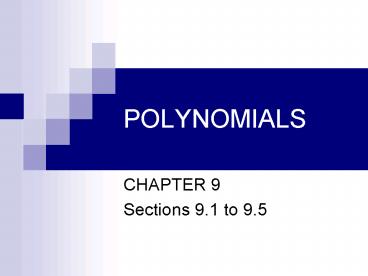POLYNOMIALS PowerPoint PPT Presentation
1 / 60
Title: POLYNOMIALS
1
POLYNOMIALS
- CHAPTER 9
- Sections 9.1 to 9.5
2
ADDING, SUBTRACTING, MULTIPLYING POLYNOMIALS
- Sections 9.1 9.2
3
A polynomial is..
- a term or a sum of terms.
- Each term is the product of a real-number
coefficient and a variable with a whole-number
exponent.
4
The degree of a polynomial is the greatest
exponent. This polynomial has degree 3.
The exponent of this variable is 1, since x1 x.
This is the linear term.
- 2x3 5x2 4x 6
This term is called the constant term of the
polynomial. Note that 6 is the same as 6x0, since
x0 1.
5
2x3 5x2 4x 6
- A polynomial whose exponents decrease from left
to right is said to be in standard form.
6
Example 1
- Tell whether each expression is a polynomial. If
so, write the polynomial in standard form and
state its degree. If not, explain why not. - a) x2 8x3 2 3x4 7x
7
Example 1
- Tell whether each expression is a polynomial. If
so, write the polynomial in standard form and
state its degree. If not, explain why not. - b) 4x -3 9x x1/2 10
8
Example 1
- Tell whether each expression is a polynomial. If
so, write the polynomial in standard form and
state its degree. If not, explain why not. - c) 7r4 2r3 5r2
9
Example 1
- Tell whether each expression is a polynomial. If
so, write the polynomial in standard form and
state its degree. If not, explain why not. - d) 6.4m m3 pm5 m2
10
Example 2
- Simplify
- (3x4 8x3 x2 2x 6) (9x4 4x2 2x 1)
11
Example 3
- Simplify
- (7x3 5x2 x 4) ( 3x2 5x 7 6x3)
12
Example 4
- Simplify
- (2x 3)(4x2 5x 8)
13
Example 5
- Simplify
- ( 3x2 x 4)(7x2 6x 5)
14
Assignment
- p 393 394 2 8 even, 20 30 even
- p 401 2 12 even
15
(No Transcript)
16
DIVIDING POLYNOMIALS
- Section 9.2
17
Remember
18
Example 1
19
Example 2
- (y3 4y2 20y 1) (y 3)
20
Example 3
21
Example 4
22
You do
23
What about?
- (4x4 4x3 11x2 16x 5) (2x2 x 5)
24
Assignment
- p 403 21 29 all
25
(No Transcript)
26
SOLVING CUBIC EQUATIONS
- Section 9.4
27
A cubic function is
- a polynomial function of degree 3.
- Standard form f(x) ax3 bx2 cx d
- Intercept form f(x) a(x p)(x q)(x r)
28
Example 1
- Let f(x) 2(x 1)(x 3)(x 4). Find the
x-intercepts of the graph of f.
29
Remember
- phrases that mean the same thing
- Roots of a function
- Solutions of the function
- Zeroes of the function
- x-intercepts of the function
30
Example 2
- Find an equation for the cubic function g whose
graph is shown.
31
Synthetic Substitution
- Evaluate 2x3 x2 3x 7 when x 20
32
Synthetic Substitution
- Evaluate 5x3 4x2 x 2 when x -3
33
Synthetic Substitution
- Evaluate 6x3 x2 1 when x 4
34
FACTOR THEOREM
- Let f(x) be a polynomial.
- Then x k is a factor of f(x) if and only if
f(k) 0
35
Finding Integral Zeroes of Polynomial Functions
- Let f be a polynomial function with integral
coefficients. Then the only possible integral
zeroes of f are the divisors of the constant
term. - For example, f(x) 3x3 x2 19x 10. The
possible integral zeroes of f are the divisors of
10 1, 2, 5, and 10.
36
Use synthetic substitution to show that f(x)
3x3 x2 19x 10 has only one integral zero.
37
Example 4
- Find the zeroes of f(x) x3 4x2 5x 8.
38
Example 5
- Find the zeroes of f(x) 10x3 33x2 23x 6
39
Assignment
- p 416 417 1 9 odd, 13 19 odd, 23, 24, 26
40
(No Transcript)
41
Finding the Zeroes of Polynomials
- Section 9.5
42
Real Zeroes of Polynomial Functions
- A polynomial function of degree n has at most n
real zeroes.
43
For example a cubic function can have 1, 2, or 3
real zeroes.
44
This function has 1 real zero
- because it has a
- triple root at (2, 0)
45
This function has 2 real zeroes
- because it has a
- double root
- at (1, 0)
46
It is possible that not all of the zeroes are
real numbers
- This function has only
- 1 real zero and the
- other two are imaginary.
47
Example 1
- Find the zeroes of f(x) x3 x2 7x 15.
48
Fundamental Theorem of Algebra
- A polynomial function of degree n has exactly n
complex zeroes, provided each double zero is
counted as 2 zeroes, each triple zero is counted
as 3 zeroes, and so on.
49
Rational Zeroes Theorem
- Let f be a polynomial function with integral
coefficients. Then the only possible rational
zeroes of f are p/q where p is a divisor of the
constant term of f(x) and q is a divisor of the
leading coefficient.
50
In other words
- Possible rational zeroes of a polynomial function
are
51
Example 2
- Find the possible rational zeroes of
- f(x) 4x3 7x2 2x 3
52
Example 3
- Find the zeroes of
- f(x) 9x4 6x3 13x2 12x 2
53
Assignment
- p 423 424 9 17 odd
54
(No Transcript)
55
Finding the Zeroes of Polynomials (cont.)
- Section 9.5
56
Assignment
- p 423 424 10 18 even
57
(No Transcript)
58
Exploring Graphs of Polynomial Functions
- Section 9.3
59
Assignment
- Worksheet
60
Summary Assignment (Review)
- p 423 2, 4
- p 458 459 1, 3 14

